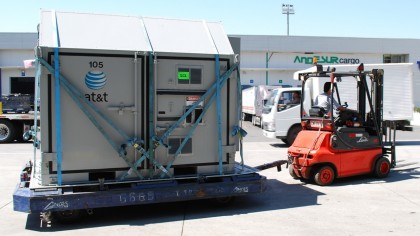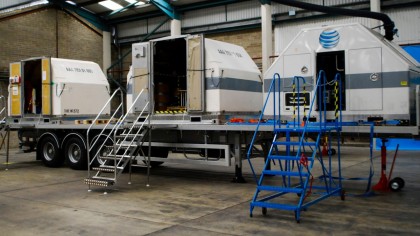Does the internet have a back-up plan?
Forget Tweetstorms
What's in the warehouse is constantly connected to the AT&T network and constitutes a PoP site in its own right – and one of the bigger ones, at that. After the exact configuration of the lost network node is copied to it, it's all driven or flown-in, to the disaster zone, then slotted-in to exactly replicate what was at the 'lost' site post-disaster. The entire fleet numbers 320 vehicles. "If you're talking about a 'smoking hole' scenario,: says Williams, "this is the only game in town."

Could terrorists bring down the internet?
Absolutely – it's known as a 'smoking hole'. "The World Trade Center at 9/11 is the classic example," says Wiliams. "We obviously monitor the media, but with something like the World Trade Center you see the call volumes around it just go bananas and you know instantly that there's been some major issue. That's when we deploy – it's so sudden.
" Since terrorist attacks can occur at any time anywhere on the planet and can produce almost any scenario, NDR is all about being prepared and ready to go. "If a government raises its threat level – as the UK did recently – then that triggers some activity for us," says Williams.
"We were linked to the local authorities and agencies that were alerting around Newport recently for the NATO Summit, and in most countries we have engineers on the ground constantly reporting back."

Without reliable communications humanitarian response teams can't function, but it's not just far-flung places that the NDR team heads out to in an emergency.
In the UK, it was activated and in deployment mode for the Buncefield fires of 2005, the 7/7 bombings and this year's floods, but this global hub is in the south of England for multiple reasons; as well as being a low-risk area it's geographically important because it's close to airports and roads. No wonder, then, that it's responsible for Europe and the Middle East.
"We'll drive these trailers as far as Turkey and the Middle East before considering flying," says Williams. The facility's location also means that the team is based in an accessible time zone for the Asia Pacific region, so that, too, also falls under its brief. It's currently on alert because of the heightened activity and protests in Hong Kong, with AT&T field engineers feeding back reports daily.
Sign up for breaking news, reviews, opinion, top tech deals, and more.
Next-gen networks
As AT&T moves towards an IP-based network, the NDR program is continuously innovating. The fleet now includes nine trailers dedicated to the recovery of the core, high-capacity routers that send and receive all of the network traffic from one network office to the next.
These trailers can support data traversing at rates as high as 100 Gigabits per second. When fully-equipped, the IP trailers can scale up to a capacity of over 15 Terabits per second.
"However you cut the future of networking you're still going to have large amounts of fibre and copper and access points that terminate onto hardware somewhere," says Williams. "If you're a data centre or you're hosting then you can move that data around very quickly," he adds, insisting that AT&T doesn't have that choice.

One of the biggest innovations of late is simple; charging stations for mobile phones. "After Superstorm Sandy in 2012 we developed charging stations, and now we rollout smaller vehicles with generators with plug sockets for people to charge their phones," says Williams. "It means they can phone their relatives who they may not have spoken to for several days."
In disasters, as in everyday life, communications is everything, but the sheer scale of AT&T's operation is impressive; the internet's back-up plan is always ready to roll.
- Also check out our sister site ITProPortal's article on Disaster Recovery as a Service (DRaaS): What businesses need to know

Jamie is a freelance tech, travel and space journalist based in the UK. He’s been writing regularly for Techradar since it was launched in 2008 and also writes regularly for Forbes, The Telegraph, the South China Morning Post, Sky & Telescope and the Sky At Night magazine as well as other Future titles T3, Digital Camera World, All About Space and Space.com. He also edits two of his own websites, TravGear.com and WhenIsTheNextEclipse.com that reflect his obsession with travel gear and solar eclipse travel. He is the author of A Stargazing Program For Beginners (Springer, 2015),